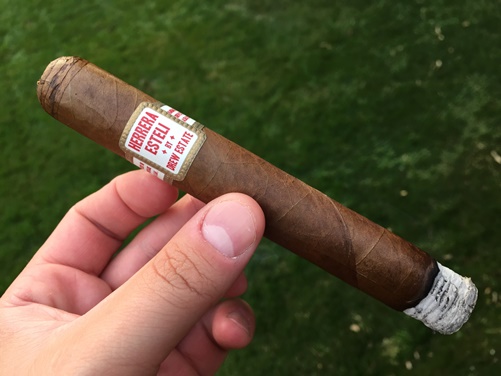Cigar Review: Montecristo White Vintage Connecticut Double Corona
28 Sep 2015
Back in July, Altadis launched an extension of its longstanding Montecristo White line called the Montecristo White Vintage Connecticut. Unlike White, which boasts a Connecticut-seed wrapper grown in Ecuador, White Vintage Connecticut has a shade-grown wrapper from 2008 that was grown on Altadis’ own farms in Connecticut.
 But the differences between the blends don’t end there. Whereas White has a Nicaraguan binder and filler tobaccos from Nicaragua and the Dominican Republic, White Vintage Connecticut has a Nicaraguan binder and a three-country filler blend of Dominican, Peruvian, and Nicaraguan tobaccos. Vintage Connecticut is also easily distinguished from its predecessor by two extra bands—one at the foot, and a large mid-section band with a picture of a red Connecticut tobacco barn. (These three bands combine to conceal the majority of the cigar’s surface.)
But the differences between the blends don’t end there. Whereas White has a Nicaraguan binder and filler tobaccos from Nicaragua and the Dominican Republic, White Vintage Connecticut has a Nicaraguan binder and a three-country filler blend of Dominican, Peruvian, and Nicaraguan tobaccos. Vintage Connecticut is also easily distinguished from its predecessor by two extra bands—one at the foot, and a large mid-section band with a picture of a red Connecticut tobacco barn. (These three bands combine to conceal the majority of the cigar’s surface.)
White Vintage Connecticut is made at Tabacalera de GarcÃa in the Dominican Republic and offered in three sizes: No. 2 Belicoso (6 x 50), No. 3 (5.5 x 44), and Double Corona (6.25 x 50). Prices range from $10.50 to $14.50, which makes the line more expensive than White (which, at around $9-11 per cigar, was already considered to be on the pricier end by some consumers).
Once the mid-section and foot bands are removed from the Double Corona, the true beauty of the vintage Connecticut leaf is on full display. The exterior is silky, golden, and smooth with a few larger veins and some wrinkles at the seams. The pre-light notes, as expected, are faint with aromas of honey, hay, and sawdust. The cold draw is stiff at first, but opens right up with a little chewing at the foot.
After setting an even light, the initial profile greets you with flavors of cream, peanut, paper, butter, almond, and vanilla. The texture is bready and the aftertaste is short with moderate cedar spice. As you’d expect from Altadis and Montecristo, construction is perfect from beginning to end.
I’d wager the binder and filler recipe was concocted specifically to not overpower the 2008 Connecticut leaf, which is surely intended to be the showcase. As such, all the traditional Connecticut flavors come through with minimal interference. And that’s ultimately what keeps this cigar from reaching its potential. While it brings you the classic tastes you’d expect from Connecticut Shade—flavors you can get from many cigars for considerably less, mind you—it fails to really complement those flavors with complexity. Instead, you’re left with a cigar that tastes creamy and nutty at its best spots, but also papery and ultra-mild at its low points.
My recommendation? Pick up this cigar if you’re looking for a mild morning smoke to pair with coffee, want to taste a vintage Connecticut Shade leaf, and budget is not a major concern. In my book, the Montecristo White Vintage Connecticut Double Corona earns three stogies out of five.

[To read more StogieGuys.com cigar reviews, please click here.]
photo credit: Stogie Guys


 That’s why, as my colleague put it
That’s why, as my colleague put it 
 Today, the 10th Anniversary isn’t difficult to find. And when you do come across a tobacconist that carries it, you won’t have trouble locating the brand on the shelf. The band’s raised borders and graphics of white really pop off the dark green background. At least to my eye, this is one of those bands that stands out and cuts through the clutter.
Today, the 10th Anniversary isn’t difficult to find. And when you do come across a tobacconist that carries it, you won’t have trouble locating the brand on the shelf. The band’s raised borders and graphics of white really pop off the dark green background. At least to my eye, this is one of those bands that stands out and cuts through the clutter.

 Agio, which was founded in 1904 by Jacques Wintermans, has recently partnered with Drew Estate to bring its cigars to the American market. The Agio portfolio includes the Balmoral Añejo 18, which had a successful launch in 2014, limited by the rarity of the 18-year-old Arapiraca wrapper.
Agio, which was founded in 1904 by Jacques Wintermans, has recently partnered with Drew Estate to bring its cigars to the American market. The Agio portfolio includes the Balmoral Añejo 18, which had a successful launch in 2014, limited by the rarity of the 18-year-old Arapiraca wrapper.
 Back in 2013, Stein created a new cigar brand called Kilo, which was made a La Aurora in the Dominican Republic (La Aurora is distributed by Miami Cigar, where Stein served as director of social media). Kilo was considered a test blend and marketed to cigar chops in New Mexico, Texas, and Maryland before it was discontinued when Stein and Miami Cigar parted ways in the spring of 2014. Miami Cigar allowed Stein to keep the Kilo trademark when he relocated to New Hampshire.
Back in 2013, Stein created a new cigar brand called Kilo, which was made a La Aurora in the Dominican Republic (La Aurora is distributed by Miami Cigar, where Stein served as director of social media). Kilo was considered a test blend and marketed to cigar chops in New Mexico, Texas, and Maryland before it was discontinued when Stein and Miami Cigar parted ways in the spring of 2014. Miami Cigar allowed Stein to keep the Kilo trademark when he relocated to New Hampshire. Patrick Ashby
Co-Founder & Editor in Chief
Patrick Ashby
Co-Founder & Editor in Chief Patrick Semmens
Co-Founder & Publisher
Patrick Semmens
Co-Founder & Publisher George Edmonson
Tampa Bureau Chief
George Edmonson
Tampa Bureau Chief